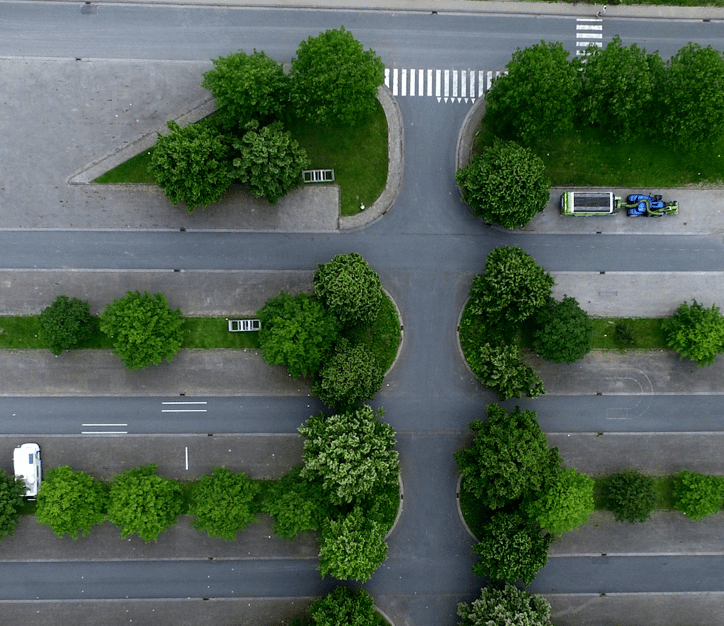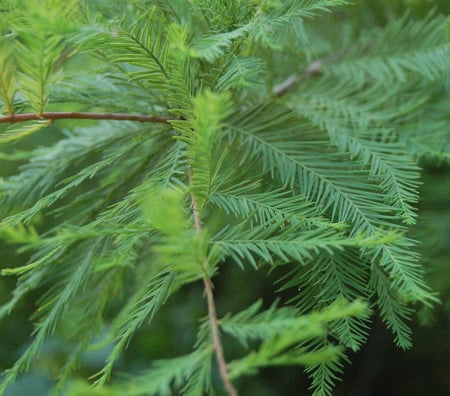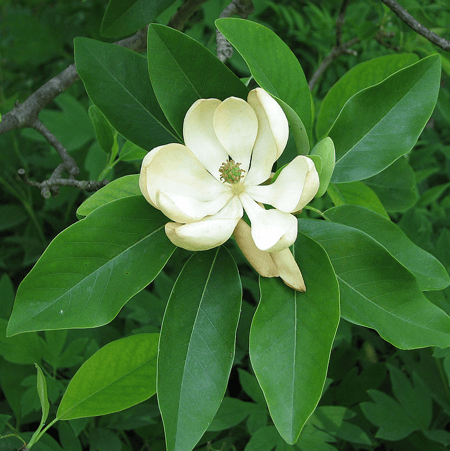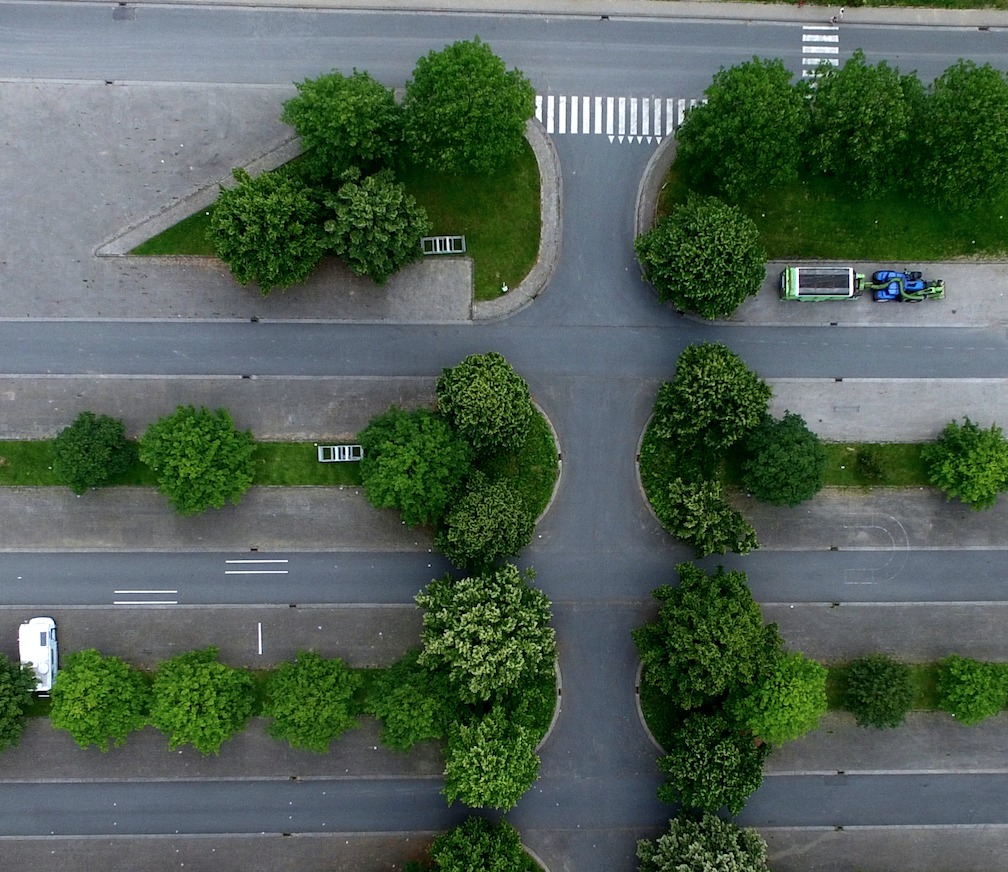Unless you think your customers and employees would enjoy the sight of a barren expanse of asphalt with nothing to shade or cool it when it heats up hotter than blazes in the summer sun, trees are a must for parking lots in the South.
However, not all trees are equal for this purpose. In fact, there are definite do’s and don’ts when comes to trees for paved areas and parking lot islands here in central and southern Georgia.

Humor me and let’s start with the don’ts. Even though we see it done all the time, I will go so far as to say that it is an egregious crime to plant any of these trees where they will be surrounded by hot asphalt:
Trees Never To Plant In Paved Areas In The South
- Any type of Maple. Maples are wonderful shade trees and we love them, but they cannot take intense heat. Many landscape architects have this knee-jerk association of maples with parking lots. Unfortunately, when you put maples anywhere near a paved area in the sunny South it doesn’t take long before their lovely trunks scald on the southern or western side and split open. This invites insects and rot, and the tree will sit there half dying for ten years until someone finally takes mercy and sntaches it up. A landscape plan that has maples in the parking lot around here is, plain and simple, the mark of a greenhorn.
- The second most abused is the lovely and delicate Dogwood. We got our hands on a landscape plan for a large church parking lot recently where the landscape architect specified dogwood trees in the islands. It makes me wonder about how we license people. Dogwoods are understory trees that grow in the southern forest in the shade of tall pines and scattered oaks. These beautiful but short-lived trees must have some protection. They will burn up as though they were in a toaster oven when planted next to a parking lot. They will probably also develop anthracnose, blights, and pestilence, and drop little limbs everywhere and die in pieces – and that’s no way to treat a lady.
- Southern Magnolia. This evergreen beauty has a beautiful form and intoxicating bloom— and continually drops one mess after another twelve months out of the year. We’re talking football-sized leaves, spent rotten blooms, and what as children we called hand grenades: big seed pods with stems sticking out that every little boy in the South has gotten yelled at for chunking at a sibling or cousin. (I can personally testify that a good, brown, cured-out magnolia pod will break a window.) Yes, they probably are the queen of Southern trees, but we don’t recommend magnolias for parking lots unless you really enjoy daily cleanup. Oh, and wherever you plant these, please don’t limb them up. Full-to-the-ground is the only way to go. These ladies look best when their ankles are covered.
- River Birch. Without a doubt, river birch is a beautiful tree. It’s also very brittle and constantly drops little branches, sticks, and leaves. This one is best planted further back in the landscape, not over paved areas.
- Anything that bears fruit, drupes or pomes. This includes all our normal fruit trees; our ubiquitous and most beloved pecan; olive trees; and we will dump into the mix Bradford pear, which is not to be planted anywhere. Even the flowering fruit trees like flowering crab still have tiny fruits. Any of these trees generally just make a mess over concrete or asphalt.
So, Which Trees Should You Use Instead?
When considering trees for paved areas, we often overlook the obvious approach: basing our selection on how well a tree is adapted to parking lot conditions. A tiny paved island offers limited soil area and root space, as well as limited water and nutrient availability. A tree that will do well planted there is one that must endure similar conditions in its native environment. Therefore the best trees for paved areas are ones that grow in swampy areas, heavy clays, very sandy soil, and similar locations where there is limited availability of nutrients, water, and/or oxygen.
Let’s look at the best trees for parking lots in Georgia by type:
Deciduous Trees For Southern Parking Lots
- Tupelo. Also called swamp black gum, this gem of a tree native to the South offers beautiful brilliant red fall color, rare for us to get in a parking lot tree unless it’s a maple, and we don’t do that, right? As a bottomland species, it survives with less oxygen and thrives in limited root space. We especially like a cultivar called Wildfire.
- Bald Cypress (pictured) and Pond Cypress (Taxus genus). It’s rare to use a conifer in a paved area in the South, but these thrive in that environment. They won’t cast a huge shade canopy, so are not appropriate for every paved area. However, they are a great choice where you need a different look to compliment architectural form. We’ve even used them for malls. They get tall and can cast shade across a building where needed. Cypress maintain a nice light bluish green throughout the season, and turn orangey russet red in the fall. Their aromatic, inoffensive needles are easily removed by maintenance crews.

- Chinese Elm. These have been somewhat overused in past decades but are still a good choice for certain situations. They have proven to be fast growers, are very tolerant of parking lot conditions with limited root space, and cast a nice shade. They are also relatively clean, although we find the tiny seeds do tend to sprout in nearby beds. We particularly like the Chinese elm cultivars Allee and Athena.
Evergreen Trees For Paved Areas In The South
- Southern Live Oak. Traditionally the live oak has been a no-no in most paved areas because it needs a lot of root space. However, there are some newer cultivars which seem to be tolerating parking lot conditions well. Cultivars like Highrise and Hightower are more upright and not so sprawling as their grandpappy, but still have the presence of a quintessential Southern oak. Live oaks are heavy producers of acorns so most avoid them. However, these are easy to remove from pavement, and we have come up with an easy solution to counter their tendency to sprout up everywhere. We just let them sprout in the mulch, and use a mower, hedge trimmer, or weed eater to keep them mowed down to 6-8 inches for a beautiful ground cover. This deciduous evergreen sheds only about 1/3 of its leaves every year. In the right setting it is one to consider.
- Sweet Bay Magnolia (pictured). This swamp bottom tree is in the magnolia family, but its maintenance requirements are not horrible. It has a much smaller leaf than the Southern magnolia, with beautiful silvery bark, and a mini version of the grenade that is much less dangerous than those of its cousin. This is a medium-growing tree with a loose and open habit, which provides some interest and a nice fragrant bloom.

Flowering Trees for Parking Lots In Georgia
- Crepe Myrtle. Other than the Sweet Bay Magnolia, this is the only flowering tree that comes to mind that gives some shade and can do well in paved areas. I would only recommend USDA Faurei hybrids like Natchez, Potomac, and Tuscarora. Natchez is our top choice. These cultivars thrive in limited root space. Heat and glare don’t faze them, and they give excellent fall color and heavy bloom set. They do unfortunately drop blooms and seed pods, but no tree is without maintenance. If you really want a flowering tree this one won’t make you curse your decision. One word of warning, though: if you do use crepe myrtles put a large bronze plaque on each one that says “Never, EVER top me!”
Looking For Parking Lot Or Paved Area Landscape Design?
If you have a parking lot, courtyard, or other paved area in need of a facelift, give us a call at 478-750-7733 or click here to contact us online. We’ll help you choose the right trees for the site that will stay healthy and beautiful for years to come without causing maintenance headaches.
1 Oct 2024



